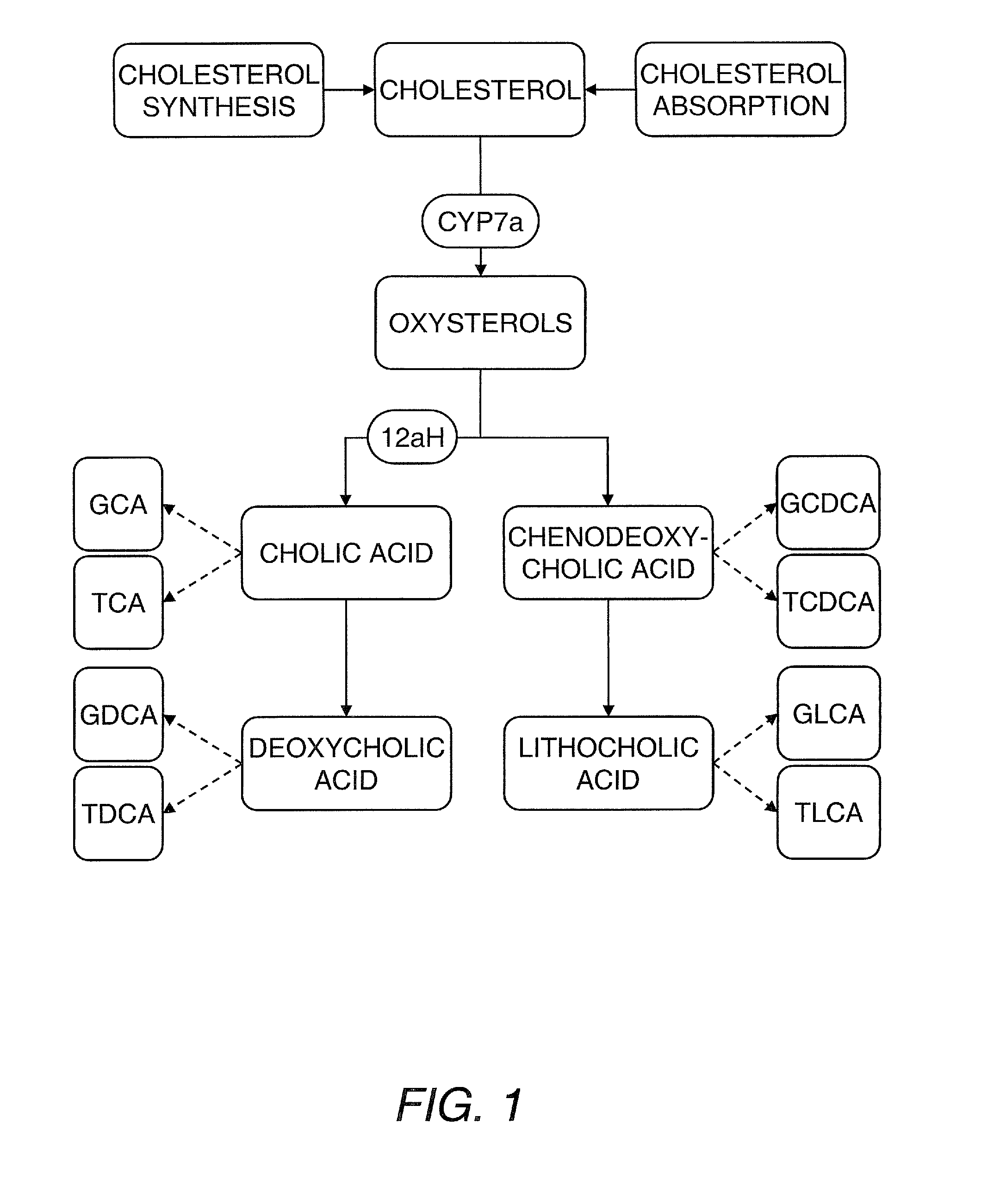Lipidomic approaches to determining drug response phenotypes in cardiovascular disease
a drug response and lipidomic technology, applied in the field of lipidomics, can solve the problems of not being able to differentiate between good and poor responders, and not being able to suggest methods of using metabolic methods
- Summary
- Abstract
- Description
- Claims
- Application Information
AI Technical Summary
Benefits of technology
Problems solved by technology
Method used
Image
Examples
example 1
Changes in Lipid Profile Following Simvastatin Treatment
[0180]We evaluated lipid profiles of 48 subjects selected from the Pharmacogenetics and Risk of Cardiovascular Disease (PARC) study. Subjects were selected from the larger study population of 944 participants (335 African-Americans and 609 whites), with a baseline total serum cholesterol level of 160 to 400 mg / dl. Participants were followed for a total of 6 weeks on simvastatin therapy (40 mg at bedtime). Twenty-four subjects drawn from the top 10% of responders and 24 age-, gender-, and race-matched subjects from the bottom 10% of responders. Response was defined as percent change in LDL cholesterol from baseline to end of treatment. Samples used in this study were collected at baseline and at 6 weeks of therapy.
Experimental
[0181]Data Reporting. Lipids measured included, butyrobetaine, L-carnitine, cholesterol, cholesterol esters (CE), diglycerides (DG), free cholesterol (FC), free fatty acids (FA), lysophosphatidylcholine (LY...
example 2
Prediction of Response
Experimental
[0201]Statistical Analysis for Prediction of Response. In order to determine if fatty acids at pre-dose were predictive of response to simvastatin, logistic regression was employed using the samples and dataset described in Example 1. The response variable was the dichotomized response and the predictors were baseline LDL cholesterol and the fatty acid. Each fatty acid was evaluated using this model. P-values and odds ratios are reported for each fatty acid.
[0202]Linear discriminant analysis was employed to evaluate the performance of sets of metabolites for prediction of response to simvastatin.
Results
[0203]Fatty acids with p-values less than 0.1 are included in Table 9. The first column shows the p-values for the covariate, baseline LDL cholesterol. The second column shows the p-value for the fatty acids. The third column shows the lower bound for the estimate of the odds ratio, the fourth column shows the estimate of the odds ratio and the last c...
example 3
Sterols, Phytosterols, Oxysterols, Bile Acids and Bile Acid Conjugates as Predictive and Response Markers
[0209]The data presented above indicates that structural and energetic lipids can weakly predict the response of individuals to statin treatment, and that these metabolites can identify individuals responding to treatment by the effect of statins on lipid metabolisms not directly related to HMG-CoA reductase inhibition. In particular, one can measure the sterols, phytosterols, oxysterols, bile acids and bile acid conjugates (e.g., from serum) to identify predictive markers of statin response. The role of these metabolites in cholesterol metabolism and cholesterol homeostasis is shown in FIG. 1 and an illustrative but nonlimiting list of these metabolites is provided hereinbelow. Individual differences in cholesterol metabolism and in the way individuals maintain cholesterol homeostasis underpin the response to statin treatment, and these differences are apparent from the panel of...
PUM
| Property | Measurement | Unit |
|---|---|---|
| time | aaaaa | aaaaa |
| time | aaaaa | aaaaa |
| time | aaaaa | aaaaa |
Abstract
Description
Claims
Application Information
 Login to View More
Login to View More - R&D
- Intellectual Property
- Life Sciences
- Materials
- Tech Scout
- Unparalleled Data Quality
- Higher Quality Content
- 60% Fewer Hallucinations
Browse by: Latest US Patents, China's latest patents, Technical Efficacy Thesaurus, Application Domain, Technology Topic, Popular Technical Reports.
© 2025 PatSnap. All rights reserved.Legal|Privacy policy|Modern Slavery Act Transparency Statement|Sitemap|About US| Contact US: help@patsnap.com



